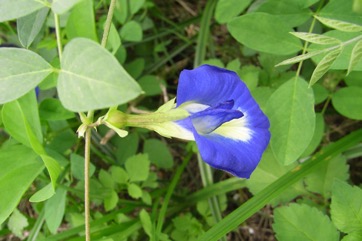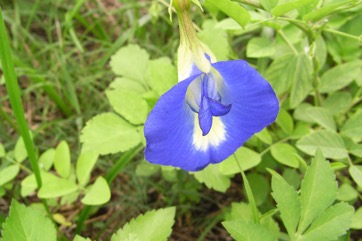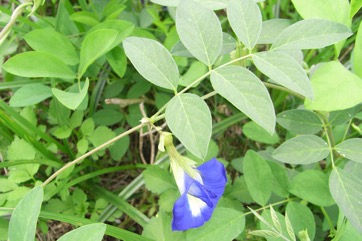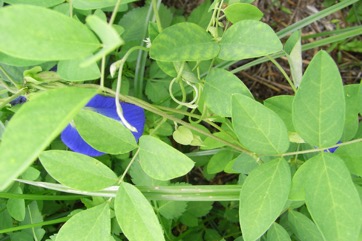Butterfly Bean, Darwin pea, Streaky Bean

It is a tropical plant. It will grow on most soils. It needs a sheltered sunny position. It is drought and frost tender. Mostly they grow on the edge of forests. It grows where the minimum temperature is 16°C. In Nepal it grows to about 250 m altitude in hedges and thickets. It can grow in arid places. In XTBG Yunnan. It suits hardiness zones 10-12.
Also known as:
Anchan, Ang chan, Anjan, Aparijita, Aporajita, Asian pigeon wings, Aung-mai-hpyu, Aung-me-nyo, Azulejo, Bejuco de conchitos, Bunga biru, Bunga telang, Campanilla, Cordofan pea, Dau biec, Gokran, Gokurna, Kacang, Kachang telang, Kakkanam, Kakkattan, Kelang, Kembang telang, Kembang teleng, Latoalawa, Menteleng, Mparia, Nanreethimaa, Oporajita, Papito, Pe-nauk-ni, Pokindang, Pukunggan, Samsampin, Sangu pushpam, Supli, Uang-chan, Zapatillo de la reina
Synonyms
- Clitoria albiflora Mattei
- Clitoria bracteata Poiret
- Clitoria coelestris Siebert & Voss
- Clitoria parviflora Raf.
- Clitoria pilosula Benth.
- Clitoria tanganicensis Micheli
- Clitoria ternatea L. var. pilosula (Benth.) Baker
- Clitoria ternatensium Crantz
- Lathyrus spectabilis Forsskal
- Ternatea ternatea (L.) Kuntze
- Ternatea vulgaris Kuntze
- Ternatea vulgaris Humboldt
Edible Portion
- Leaves, Pods, Flowers - tea, Flowers
Where does Butterfly Bean grow?
Found in: Africa, Angola, Antigua-Barbuda, Aruba, Asia, Australia, Bahamas, Bangladesh, Barbados, Belize, Benin, Bhutan, Bolivia, Brazil, Burkina Faso, Burundi, Cabinda, Cambodia, Cameroon, Cape Verde, Caribbean, Cayman Islands, Central Africa, Central America, Chad, China, Colombia, Comoros, Congo, Costa Rica, Côte d'Ivoire, Cuba, Djibouti, Dominica, Dominican Republic, East Africa, Ecuador, El Salvador, Ethiopia, Fiji, French Guiana, Gabon, Gambia, Germany, Ghana, Guadeloupe, Guianas, Guam, Guatemala, Guinea, Guinée, Guinea-Bissau, Guyana, Haiti, Hawaii, Himalayas, Honduras, India, Indochina, Indonesia, Iran, Iraq, Ivory Coast, Jamaica, Kenya, Kiribati, Laos, Madagascar, Malawi, Malaysia, Maldives, Mali, Marianas, Marquesas, Martinique, Mauritius, Mexico, Micronesia, Montserrat, Mozambique, Myanmar, Namibia, Nauru, Nepal, New Caledonia, Nicaragua, Niger, Nigeria, North America, Pacific, Pakistan, Palau, Panama, Papua New Guinea, PNG, Paraguay, Peru, Philippines, Puerto Rico, Reunion, Sao Tome and Principe, Saudi Arabia, SE Asia, Seychelles, Senegal, Sierra Leone, Singapore, Solomon Islands, Somalia, South Africa, Southern Africa, South America, Sri Lanka, Sudan, Suriname, Taiwan, Tanzania, Thailand, Togo, Tonga, Tuvalu, Uganda, Uruguay, United States, Venezuela, Vietnam, West Africa, West Indies, West Timor, Yemen, Zambia, Zimbabwe
Notes: It becomes a weed in many places forming tangled hedges. There are about 40 Clitoria species. In the Botanical Gardens in Slovenia - presumably in a hot house.
Growing Butterfly Bean, Darwin pea, Streaky Bean
Cultivation: Plants can be grown from seed or cuttings. For seed the temperature should be at least 19-24°C. Seeds can be slow to germinate. This can be improved by filing, or soaking in hot water to break the hard seed coat. It is grown as an annual plant in temperate zones.
Edible Uses: CAUTION: The seeds are poisonous. The leaves are cooked and eaten. The juice is also used to colour food green. The flowers are cooked with rice to colour it blue. The dried flowers are steeped in boiling water and the coloured water used to tint rice cakes and sweets. The flowers are also eaten in salads. The young pods are cooked and eaten. The seeds are used in soup.
Nutrition Info
per 100g edible portion| Edible Part | Energy (kcal) | Protein (g) | Iron (mg) | Vitamin A (ug) | Vitamin c (mg) | Zinc (mg) | % Water |
|---|---|---|---|---|---|---|---|
| Pods & Seeds | 66 | 3.8 | 0.4 | - | - | - | 80 |
Butterfly Bean, Darwin pea, Streaky Bean Photos




References
Ambasta, S.P. (Ed.), 2000, The Useful Plants of India. CSIR India. p 133
Aniama, S. O., et al, 2016, Ethnobotanical documentaton of some plants among Igala people of Kogi State (Nigeria). The International Journal Of Engineering And Science (IJES). 5(4) pp 33-42
Ara, R. I. T., 2015, Leafy Vegetables in Bangladesh. Photon eBooks. p 119
Bodkin, F., 1991, Encyclopedia Botanica. Cornstalk publishing, p 268
Borrell, O.W., 1989, An Annotated Checklist of the Flora of Kairiru Island, New Guinea. Marcellin College, Victoria Australia. p 89
Brickell, C. (Ed.), 1999, The Royal Horticultural Society A-Z Encyclopedia of Garden Plants. Convent Garden Books. p 282
Burkill, I.H., 1966, A Dictionary of the Economic Products of the Malay Peninsula. Ministry of Agriculture and Cooperatives, Kuala Lumpur, Malaysia. Vol 1 (A-H) p 596
Cooper, W. and Cooper, W., 2004, Fruits of the Australian Tropical Rainforest. Nokomis Editions, Victoria, Australia. p 205
Cundall, P., (ed.), 2004, Gardening Australia: flora: the gardener's bible. ABC Books. p 394
Engel, D.H., & Phummai, S., 2000, A Field Guide to Tropical Plants of Asia. Timber Press. p 196
Facciola, S., 1998, Cornucopia 2: a Source Book of Edible Plants. Kampong Publications, p 103
Flora of Pakistan. www.eFloras.org
Food Composition Tables for use in East Asia FAO http://www.fao.org/infoods/directory No. 665
Frantz, P. R., 1991, Ethnobotany of Clitoria. Economic Botany 45(4): 511-520
Hedrick, U.P., 1919, (Ed.), Sturtevant's edible plants of the world. p 205
Henty, E.E., & Pritchard, G.S., 1973, Weeds of New Guinea and their control. Botany Bulletin No 7, Division of Botany, Lae, PNG. p 119
Hibbert, M., 2002, The Aussie Plant Finder 2002, Florilegium. p 70
Hossain, U. & Rahman, A., 2018, Study and quantitative analysis of wild vegetable floral diversity available in Barisal district, Bangladesh. Asian J. Med. Biol. Res. 2018, 4 (4), 362-371
Hussey, B.M.J., Keighery, G.J., Cousens, R.D., Dodd, J., Lloyd, S.G., 1997, Western Weeds. A guide to the weeds of Western Australia. Plant Protection Society of Western Australia. p 148
ILDIS Legumes of the World http:www:ildis.org/Legume/Web
Jackes, B.R., 2001, Plants of the Tropics. Rainforest to Heath. An Identification Guide. James Cook University. p 54
Kaewnarin, K., et al, 2014, Antioxidant and Antiglycation Activities of Some Edible and Medicinal Plants. Chiang Mai J. Sci. 2014; 41(1) : 105-116
Kenneally, K.E., Edinger, D. C., and Willing T., 1996, Broome and Beyond, Plants and People of the Dampier Peninsula, Kimberley, Western Australia. Department of Conservation and Land Management. p 153
Lazarides, M. & Hince, B., 1993, Handbook of Economic Plants of Australia, CSIRO. p 62
Liu, Yi-tao, & Long, Chun-Lin, 2002, Studies on Edible Flowers Consumed by Ethnic Groups in Yunnan. Acta Botanica Yunnanica. 24(1):41-56
Llamas, K.A., 2003, Tropical Flowering Plants. Timber Press. p 217
Lugod, G.C. and de Padua L.S., 1979, Wild Food Plants in the Philippines. Vol. 1. Univ. of Philippines Los Banos. p 46
Maghirang, R. G., et al, 2018. Ethnobotanical Studies of Some Plants Commonly Used as Vegetables in Selected Provinces of the Philippines. Journal of Nature Studies. 17(2), 30-43.
Manandhar, N.P., 2002, Plants and People of Nepal. Timber Press. Portland, Oregon. p 162
Martin, F.W. & Ruberte, R.M., 1979, Edible Leaves of the Tropics. Antillian College Press, Mayaguez, Puerto Rico. p 71, 198
McMakin, P.D., 2000, Flowering Plants of Thailand. A Field Guide. White Lotus. p 96
Morley, B. & Everard, B., 1970, Wild Flowers of the World. Ebury press. Plate 53
Paczkowska, G . & Chapman, A.R., 2000, The Western Australian Flora. A Descriptive Catalogue. Western Australian Herbarium. p 421
Peekel, P.G., 1984, (Translation E.E.Henty), Flora of the Bismarck Archipelago for Naturalists, Division of Botany, Lae, PNG. p 247, 244
Pham-Hoang Ho, 1999, An Illustrated Flora of Vietnam. Nha Xuat Ban Tre. p 953
Plants of Haiti Smithsonian Institute http://botany.si.edu/antilles/West Indies
Polinag, M. A., 2003, Food from the Wilderness. Department of Environment and Natural Resources. Laguna.
Royal Botanic Gardens, Kew (1999). Survey of Economic Plants for Arid and Semi-Arid Lands (SEPASAL) database. Published on the Internet; http://www.rbgkew.org.uk/ceb/sepasal/internet [Accessed 28th April 2011]
Shumsky, S., et al, 2014, Institutional factors affecting wild edible plant (WEP) harvest and consumption in semi-arid Kenya. Land Use Policy 38(2014) 48-69
Sp. pl. 2:753. 1753
Sujanapal, P., & Sankaran, K. V., 2016, Common Plants of Maldives. FAO & Kerala FRI, p 90
Sukarya, D. G., (Ed.) 2013, 3,500 Plant Species of the Botanic Gardens of Indonesia. LIPI p 1090
Tamil herbs, 2007, Edible Plants of the Tropical Dry Evergreen Forest.
Thaman, R. R., 1987, Plants of Kiribati: A listing and analysis of vernacular names. Atoll Research Bulletin No. 296
Thaman, R. R, 2016, The flora of Tuvalu. Atoll Research Bulletin No. 611. Smithsonian Institute p 89
Wheeler, J.R.(ed.), 1992, Flora of the Kimberley Region. CALM, Western Australian Herbarium, p 378
World Checklist of Useful Plant Species 2020. Royal Botanic Gardens, Kew
Yuncker, T.G., 1959, Plants of Tonga, Bernice P. Bishop Museum, Hawaii, Bulletin 220. p 145